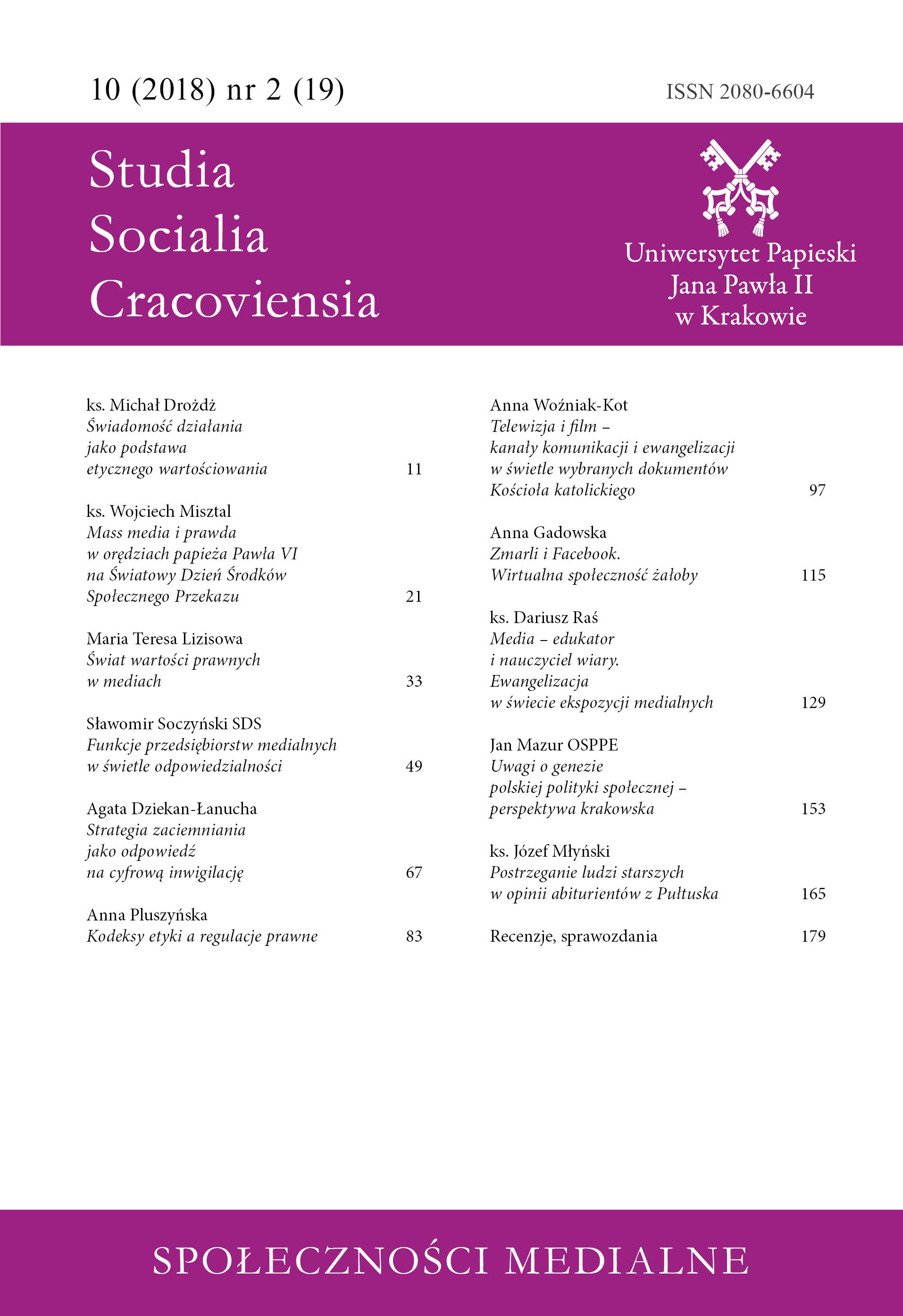Media – edukator i nauczyciel wiary. Ewangelizacja w świecie ekspozycji medialnych
DOI:
https://doi.org/10.15633/ssc.3338Słowa kluczowe:
nauczyciel, media, wiara, edukacja, kompetencjaAbstrakt
Ewangelizacja w świecie ekspozycji medialnych. „Cyfrowi tubylcy” zwani pokoleniem multitasking czy „generacją Z”, składają swój świat z tysiąca puzzli. A to nie wystarczy, aby poznać tajemnicę człowieka, spotkać się z kulturą, odkryć wielkie tradycje oraz zasmakować wiary w osobowego Boga. Niektórym złudnie się wydaje, że wystarczy jeden klik i odczytanie 140 znaków, aby osiągnąć wiedzę, poznać prawdę czy dotknąć sedna sprawy. Ten tekst ma posłużyć praktycznemu odkryciu zasady, że media są w ostatecznym rozrachunku bardziej zdobyczą ludzką niż technologiczną. Używanie mediów tradycyjnych i nowoczesnych może stać się dla człowieka drogą do pogłębienia siebie i znalezienia śladów Stwórcy. Takie kompetencje można nabyć przy udziale świadomych rodziców, inspirujących nauczycieli, katechetów, animatorów wspólnot. Oni wskażą inspiracje płynące z doświadczenia wiary w kontekście zdobyczy komunikacyjnych najnowszej generacji. Prawdziwa nauka wiary prowadzi do poznania Boga, rozróżnienia, co dobre, a co złe w kontekście współczesnym. Kompetentny nauczyciel wiary odkrywa przed młodym wartości najdonioślejsze: miłość, życie, rodzinę, prawdę w kontekście Ewangelii, a czyni to, niejednokrotnie używając nowego języka i nowych narzędzi przekazu.
Bibliografia
Alvarado M., Boyd-Barrett O., Media Education: an Introduction, London 1992.
Banaszkiewicz-Zygmunt E., Media. Leksykon, Warszawa 2000.
Dziennikarstwo i świat mediów, red. Z. Bauer, E. Chodziński, Kraków 2000.
Bąk A., Korzystanie z urządzeń mobilnych przez małe dzieci w Polsce. Wyniki badania ilościowego, Warszawa 2015.
Buckingham D., Media Education: Literacy, Learning and Contemporary Culture, Cambridge 2003.
Komunikacja wiary w trzecim tysiącleciu, red. S. Dziekoński, Olecko 2000.
Foley P., Bobinger U., Bóg w globalnej wiosce, tłum. M. Rodkiewicz, Kraków 2000.
Franciszek, http://pl.radiovaticana.va/news/2017/05/27/papież_do_młodych_miejcie_serce _marynarza,_odważne _i_sięgaj/1315235 (21.11.2017).
Franciszek, Przekaz w służbie autentycznej kultury spotkania. Orędzie papieża Franciszka na XLVIII Światowy Dzień Środków Społecznego Przekazu (24.01.2014), http://w2.vatican.va/content/francesco/pl/messages/communications/documents/papa-francesco_20140124_messaggio-comunicazioni-sociali.html (30.10. 2017).
Garcarek A., Realizacje muzycznych formatów stacji radiowych na polskim rynku medialnym, „Folia Litteraria Polonica” 17 (2012) 3, s. 182–188.
Gianatelli R., Media Education, w: La comunicazione, a cura di F. Lever, Roma 2002, s. 722–727.
Gurba K., Sieć i życie w standby, w: Bramy prawdy i wiary. Benedykt XVI o mediach, Kraków 2016, s. 131–147.
Howard D., Mabley E., Gli strumenti dello sceneggiatore, Roma 1999.
Janus-Kwiatkowska K., Mechanizmy perswazyjne w rekalmie, http://em.pwn.pl/media/reklama.html (13.15.2004).
Królikowska A., Luszczak G., Marek Z., Dydaktyka obrazu, Kraków 2000.
Laszczak M., Psychologia przekazu reklamowego, Kraków 2000.
Masterman L., A scuola dei media, Brescia 1994.
Młodzież a Internet – raport z badań CBOS, http://www.uzaleznieniabehawioralne.pl/raporty-z-badan/mlodziez-a-internet-raport-z-badan-cbos/ (18.04.2017).
Pisarek W., Nowa retoryka dziennikarska, Kraków 2011.
Pyżalski J., Klichowski M., Przybyła M., Szanse i zagrożenia w obszarze wykorzystania technologii informacyjno-komunikacyjnych (TIK), ze szczególnym uwzględnieniem aplikacji mobilnych, Poznań 2014.
Raś D., Wychowanie katechizowanych do odbioru mediów, www.katecheza.episkopat.pl/download/ Wychow_do_odbioru_mediow.doc (28.10.2017).
Reeves B, Nass C., Media i ludzie, przeł. H. Szczerkowska, Warszawa 2000.
Strykowski W., Media i edukacja medialna w tworzeniu współczesnego społeczeństwa, w: www.kmti.uz.zgora.pl/pages/referaty/strykowski.pdf (12.05.2004).
Strykowski W., Rola mediów i edukacji medialnej w współczesnym społeczeństwie, „Chowanna” 20 (2013) nr 1, s. 111–122.
Ulfik-Jaworska I., Czy gry komputerowe mogą być niebezpieczne?, http://www.katolik.pl/czy-gry-komputerowe-moga-byc-niebezpieczne-,2110,416,cz.html?s=5 (20.10.2017).
Vandendorpe Ch., Od papirusu do hipertekstu. Esej o przemianach tekstu i lektury, tłum. A. Sawisz, Warszawa 2008.
Wądołowski M., Literatura hipertekstowa – (r)ewolucja czy chaos?, http://krytyka.org/literatura-hipertekstowa-rewolucja-czy-chaos/ (3.11.2016).
Sandbothe M., Transwersalne światy medialne. Filozoficzne rozważania o Internecie, tłum. K. Krzemieniowa, w: Widzieć, myśleć, być. Technologie mediów, red. A. Gwóźdź, Kraków 2011, s. 211–221.
www.dzieckowsieci.pl (17.10.2017).
https://e-religijne.pl/pl/c/Religijne-gry-komputerowe/324 (25.10.2017).
http://mamatatatablet.pl/campaign/ (21.04.2017).
https://socialpress.pl/2017/05/22-serwisy-spolecznosciowe-z-ktorych-korzystamy-najczesciej/ (24.11.2017).
https://wydawnictwowam.pl/plyty/dla-dzieci (21.11.2017).
Pobrania
Opublikowane
Numer
Dział
Licencja
Autorzy publikujący w czasopiśmie udzielają jego wydawcy zgody o następującej treści:
- Autor zachowuje autorskie prawa majątkowe do utworu, a jednocześnie udziela wydawcy czasopisma zgody na jego pierwszą publikację w wersji drukowanej i wersji online na licencji Creative Commons Uznanie autorstwa 4.0 Międzynarodowe oraz zgody na wykonywanie opracowań, w tym przekładów.
- Autor ma możliwość udzielania zgody niewyłącznej na opublikowanie utworu w wersji, która ukazała się w czasopiśmie (np. zamieszczenia go w repozytorium instytucjonalnym lub opublikowania w książce), wraz z informacją o jego pierwszej publikacji w czasopiśmie.
- Autor może umieścić swój utwór online (np. w repozytorium instytucjonalnym lub na swojej stronie internetowej) jeszcze przed zgłoszeniem utworu do czasopisma.

